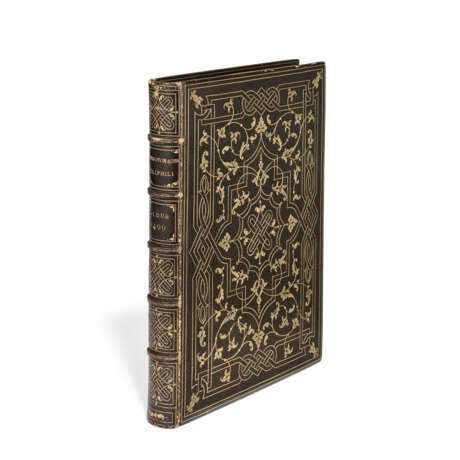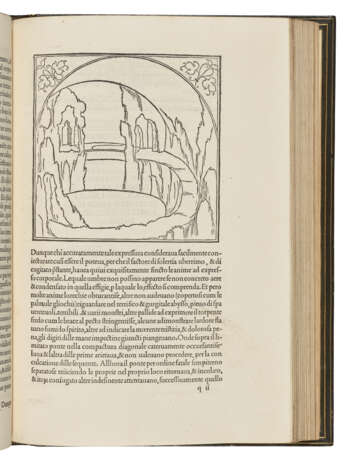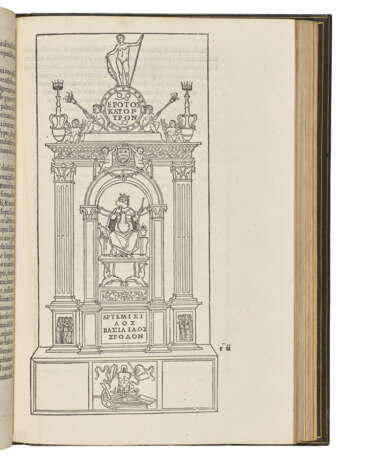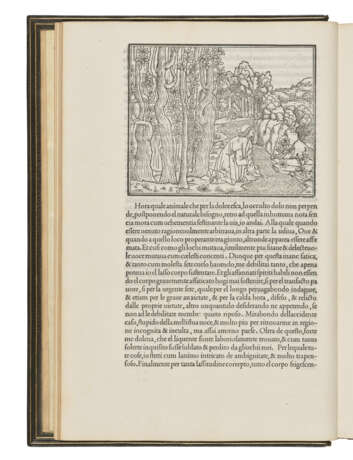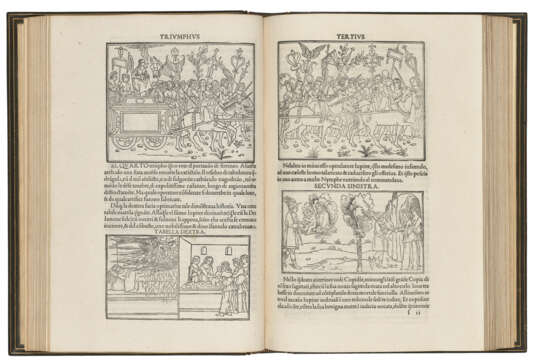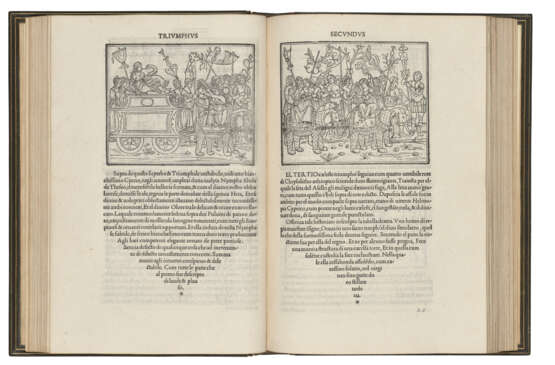ID 1353369
Lot 41 | Hypnerotomachia Poliphili
Estimate value
£ 120 000 – 160 000
First edition of the most influential illustrated printed book of the Italian renaissance and a major landmark of imagination and fantasy.
Read and admired by major Renaissance intellectuals, Colonna's Hypnerotomachia Poliphili has exerted an important influence on artists, writers, and architects throughout the centuries. Its pioneering world-building methods helped to shape William Morris’s epic poem The Earthly Paradise, which would go on to inspire the works of J.R.R. Tolkien. The first edition continues to be revered for the publisher’s mastery of type, design and illustration, which here come together at their highest level.
The Hypnerotomachia Poliphili is an Inception-like ‘dream within a dream’ narrative in which the protagonist, Poliphilo, embarks on a fantastical journey through a surreal and richly detailed architectural landscape. This dream-like setting, full of mythological creatures, elaborate gardens, and mysterious ruins, is a hallmark of later fantasy world-building and is depicted visually throughout the volume by the 172 fine woodcut illustrations which would have a profound influence on artists such as Burne-Jones, Rossetti and Beardsley. The text is written in ‘an extraordinarily exotic Latinate vernacular, a language never spoken and never again attempted in Latin literature’ (Davies), creating an unfamiliar universe of words coined from Latin and Greek, with unexpected linguistic formulations, and occasional appearances of Arabic, Hebrew and pseudo-Egyptian hieroglyphs.
The work contains a hidden acrostic formed by the first, elaborately woodcut initial in each chapter. When these letters are combined, they spell out: POLIAM FRATER FRANCISCVS COLVMNA PERAMAVIT, which translates as: ‘Brother Francesco Colonna has dearly loved Polia.’ This acrostic has been widely interpreted as revealing the true author of the work to be Francesco Colonna, a Dominican friar who lived from 1433 to 1527. However, the authorship of the Hypnerotomachia Poliphili has been a subject of debate among scholars, with some attributing it to other figures such as Leon Battista Alberti or Lorenzo de' Medici and Servite friar Eliseo da Treviso. The presence of this hidden message adds another layer of intrigue to an already mysterious and complex work, and reflects the book's overall arcane and allegorical character.
The woodcuts, a few of which are signed with the initial ‘b’, have been tentatively attributed to the Paduan miniaturist Benedetto Bordone, but like the many rival attributions this one remains contestable. ISTC ic00767000; HC 5501*; Pr 5574*; GW 7223; BMC V, 561; Renouard Alde 21.5; Essling 1198; Sander 2056; Schäfer/von Arnim 107; Goff C-767.
Chancery folio (289 x 204mm). 172 woodcuts, including 11 full-page illustrations, 39 woodcut initials, printed from 17 blocks, forming an acrostic including the dedicatee and probable author's name, Franciscus Columna (very small worm track from E1 to F4 affecting not more than 4 letters in each leaf, leaves b8, il and r1 each with a tiny perforation or filled wormhole catching one or two letters, discreet marginal repairs to four leaves, a very few small stains, a few letters inked over [see Provenance below]; the Priapus cut on m6 is intact). Black morocco, covers gilt-tooled in a Grolieresque pattern of interlacing strapwork and leafy vines with azuré infill within double gilt fillet border, spine in six compartments, four similarly gilt, two gilt-lettered, gilt edges, double vellum endleaves, by Bedford (joints and extremities lightly rubbed). Provenance: errata leaf with old ink underlinings – scattered neat eighteenth or nineteenth-century interlinear corrections and insertions with occasional deletions of letters, ink doodle on b7v (woodcut of elephant), signatures of unsigned leaves added in pencil – erased inscription on front free endleaf (‘Rosenbach Jan. 4 1909 ...’) – trace of removed bookplate on second endleaf – Clarence S. Bemens, bookplate – Christie’s New York 9 June 1993, lot 31.
| Place of origin: | Italy |
|---|---|
| Auction house category: | Antiquarian books, Printed books |
| Place of origin: | Italy |
|---|---|
| Auction house category: | Antiquarian books, Printed books |
| Address of auction |
CHRISTIE'S 8 King Street, St. James's SW1Y 6QT London United Kingdom | |
|---|---|---|
| Preview |
| |
| Phone | +44 (0)20 7839 9060 | |
| Buyer Premium | see on Website | |
| Conditions of purchase | Conditions of purchase |
